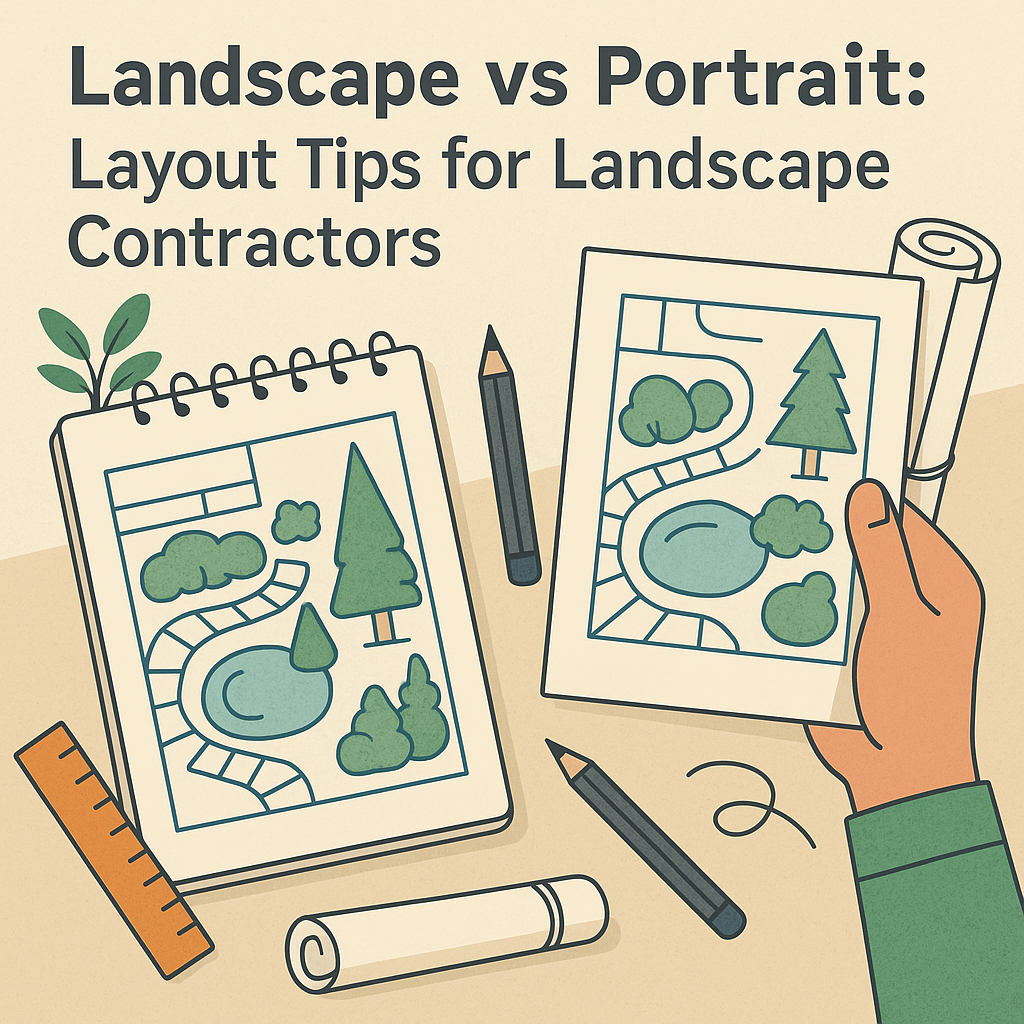For landscape contractors, effective visual presentation is vital in communicating ideas clearly to clients and stakeholders. A key aspect of professional visual communication is deciding between landscape vs portrait layouts. This choice not only impacts aesthetics but also significantly affects viewer engagement, content comprehension, and project success. In this guide, we’ll explore the best practices for landscape contractors when choosing between landscape and portrait layouts, highlighting their strengths, weaknesses, and optimal usage scenarios.
Understanding Landscape vs Portrait Layouts
Before delving into best practices, let’s define and differentiate between these orientations clearly:
Landscape Layout
- Landscape orientation is horizontal, wider than it is tall.
- Best suited for capturing expansive scenes, wide garden designs, and broad architectural elements.
- Aligns naturally with human peripheral vision, enhancing viewer comfort.
Portrait Layout
- Portrait orientation is vertical, taller than it is wide.
- Ideal for highlighting vertical elements such as trees, buildings, or sculptures.
- Encourages focused attention on narrower fields, suitable for detailed presentations and visual storytelling.
Understanding these fundamental differences lays a strong foundation for choosing the optimal orientation based on your project’s needs.
Why Orientation Matters in Landscape Contracting
Orientation isn’t simply about aesthetics—it’s central to viewer interaction and understanding. Properly selected orientation guides the viewer’s eyes effectively through your visuals, emphasizing key design elements. The correct choice between landscape vs portrait enhances your visual storytelling capabilities, aids in effective eye-tracking, and increases comprehension and retention of your design concepts.
Moreover, correct paper orientation ensures optimal presentation quality, especially when considering printed materials like blueprints, brochures, and proposals. Learn more about print considerations in our detailed guide: Landscape vs Portrait: Best for Printing?
Best Practices for Choosing Between Landscape and Portrait Layouts
1. Match Orientation with Your Content Type
Landscape Layouts for Broad and Detailed Plans
- When preparing comprehensive site plans, expansive gardens, or panoramic views, opt for landscape layouts.
- Horizontal drawing allows contractors to represent multiple site elements clearly, showcasing landscape features like paths, lawns, pools, and garden beds cohesively.
- Ideal for aerial views, site overviews, and master plans.
Portrait Layouts for Vertical Features and Focused Elements
- Choose portrait layouts when your subject demands height emphasis, such as showcasing tall hedges, vertical gardens, fountains, or architectural details like gates and fences.
- Portrait orientation emphasizes height and vertical scale effectively through vertical drawing and focused visuals.
2. Enhance Visual Storytelling and Composition
Proper orientation supports effective visual storytelling and helps maintain clear composition techniques:
- Landscape layouts allow a natural left-to-right progression, accommodating wide, panoramic views. This orientation helps viewers quickly grasp the broader context and flow of outdoor spaces.
- Portrait layouts are beneficial when sequential vertical viewing or detailed focus is essential, enhancing viewer attention on singular, vertical focal points.
Explore how orientation impacts visual storytelling in art with our comprehensive overview: Landscape vs Portrait in Art: Key Differences
3. Align Layout Orientation with Presentation Medium
The medium through which designs are presented significantly influences layout choice:
- Digital screens: Landscape orientation typically aligns better with widescreen monitors, presentations, and digital devices, facilitating broader viewing experiences and less scrolling.
- Printed materials: Portrait layouts suit brochures, detailed project descriptions, and documentation intended for physical handling and vertical reading. For more on print layout optimization, check out: Landscape vs Portrait: Best for Printing?
4. Consider the Audience and Context
Audience preferences and the context of your presentation are crucial in layout choice:
- Professional clients and architects often prefer detailed, expansive views offered by landscape orientation, especially for complex projects involving comprehensive site plans.
- Homeowners and smaller projects often appreciate portrait layouts, which clearly highlight specific design elements in a focused manner, facilitating better understanding and communication.
5. Combine Both Orientations When Needed
There’s no rigid rule requiring exclusive use of one orientation. Combining both orientations strategically within a single presentation can enhance clarity and effectiveness:
- Start with a landscape overview layout, providing context and breadth.
- Transition to portrait layouts for detailed close-ups or vertical-specific elements, ensuring comprehensive and engaging presentations.
Applying Orientation Best Practices to Landscape Design Architecture
In landscape design architecture, correct orientation aids in effectively communicating spatial relationships and design concepts. Properly chosen drawing orientation ensures architectural clarity, enhances art exploration, and facilitates accurate client expectations:
- Use landscape layouts for comprehensive architectural and environmental context.
- Employ portrait layouts for elevation drawings, detailed sections, and vertical compositions emphasizing architectural or natural height features.
Discover detailed insights into graphic design applications here: Landscape vs Portrait in Graphic Design
Practical Visual Exercises for Landscape Contractors
Here are practical visual exercises to refine your skills in choosing the right layout orientation:
- Thumbnail Sketching: Quickly sketch designs in both landscape and portrait orientations, comparing the effectiveness of each. Identify which orientation emphasizes critical design elements better.
- Eye-tracking Test: Present colleagues or clients with both orientations, observing which layout guides their eye movement naturally and clearly.
- Composition Comparison: Regularly practice designing the same site in both orientations. Identify strengths and weaknesses regarding composition, flow, and viewer engagement.
These visual exercises enhance understanding of practical impacts and help reinforce effective decision-making skills.
Conclusion: Optimal Orientation for Effective Communication
Choosing between landscape vs portrait layouts is pivotal for landscape contractors, influencing visual clarity, professional presentation, and client engagement. Remember these core guidelines:
- Landscape: Best for expansive, detailed, horizontally-oriented presentations and overviews.
- Portrait: Ideal for emphasizing height, vertical elements, and focused visual narratives.
Employing these best practices consistently will enhance your professional presentations, boost client satisfaction, and lead to greater project success.
Explore Further with Our Guides:

